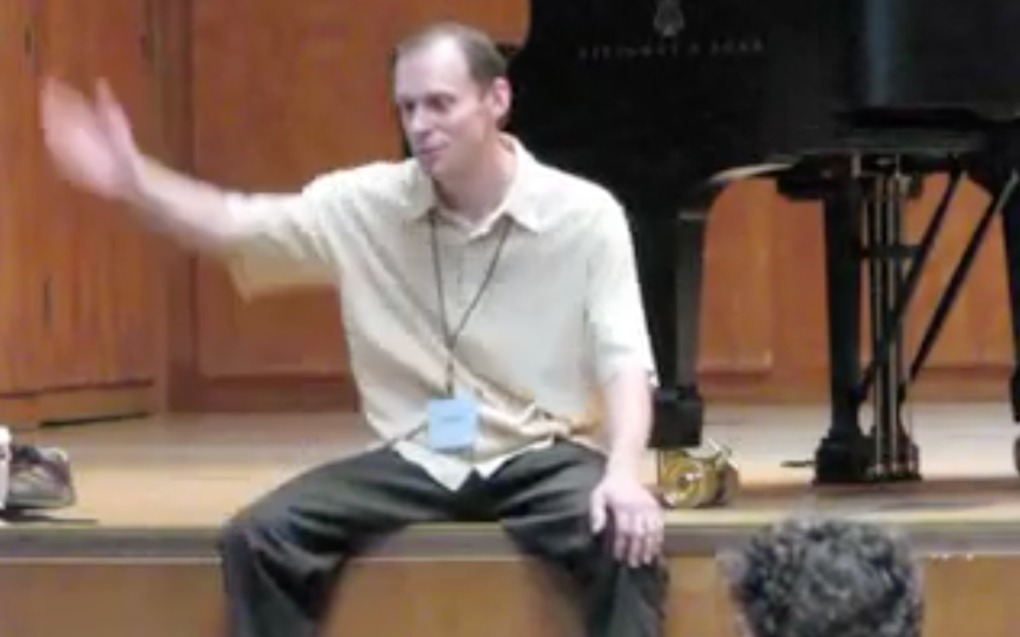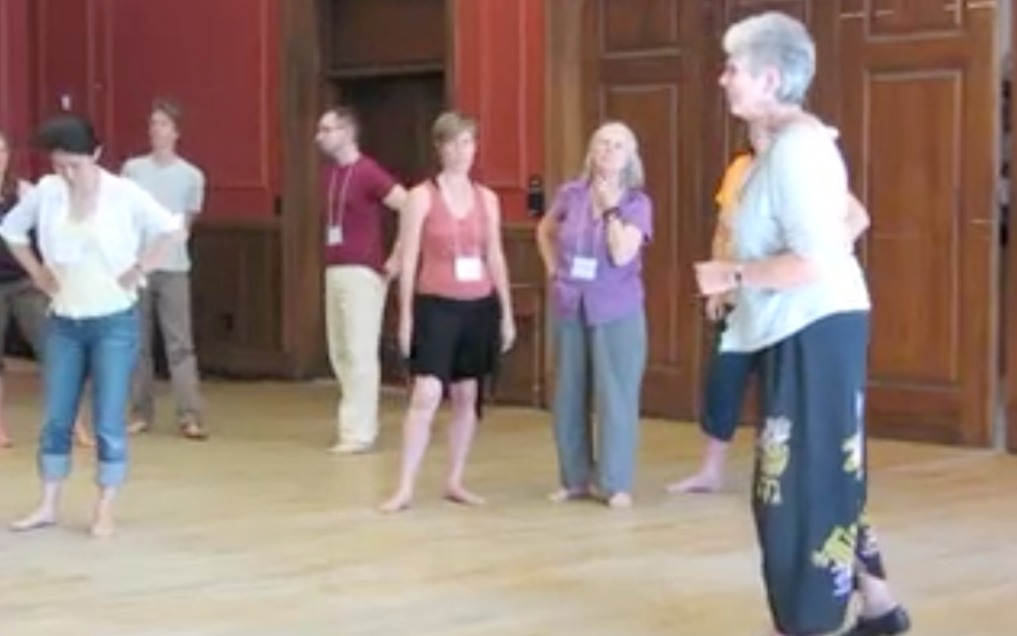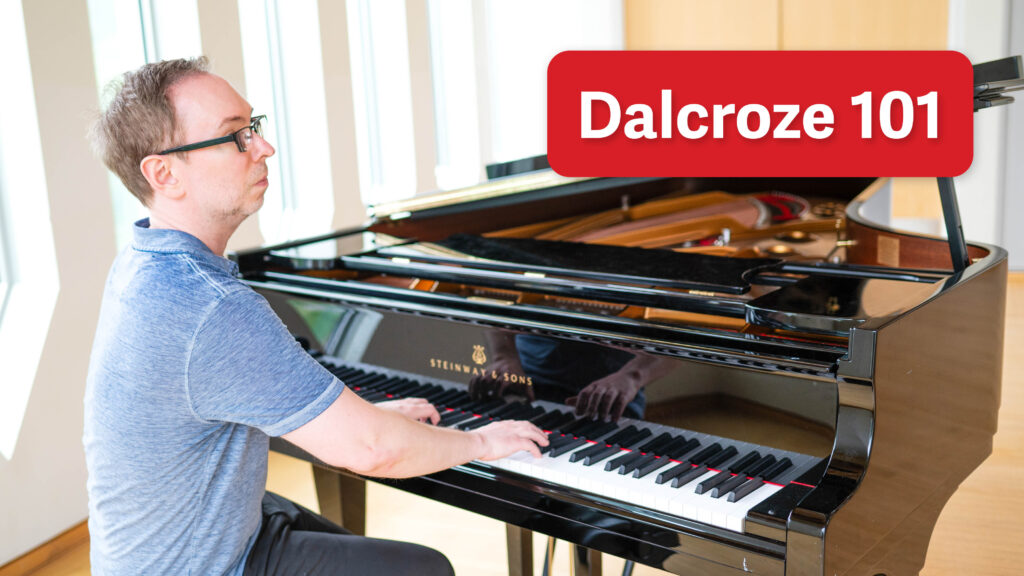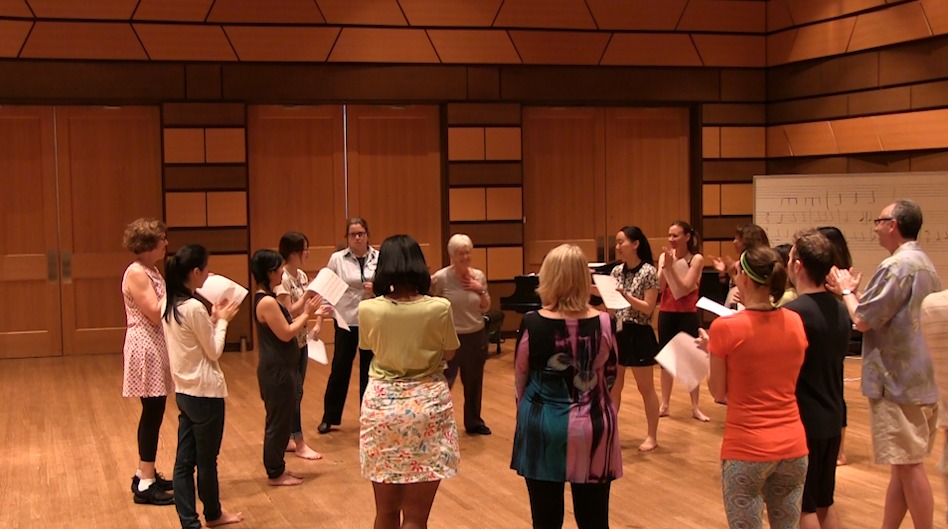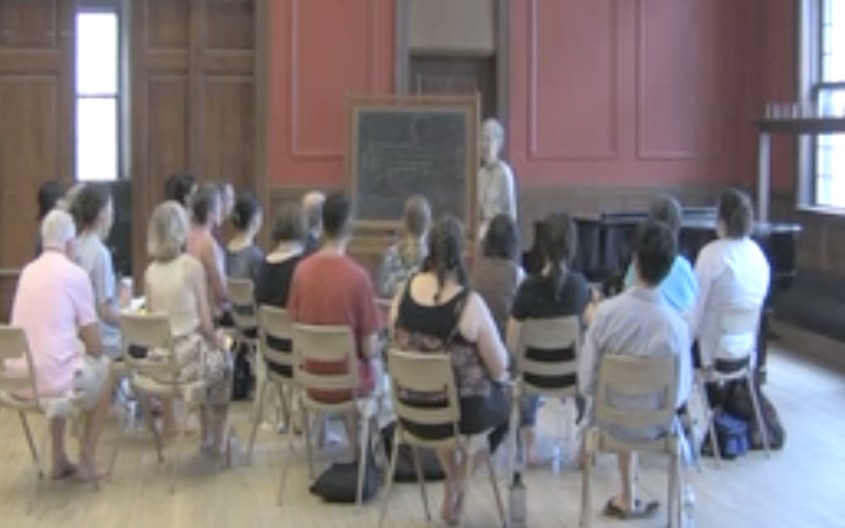Piano Improv: Creating Contemporary Harmonies
With Melissa Tucker, Dalcroze License
Recorded January 15, 2023
Members Only Resource
Please log in or become a member to watch this video.
Have you ever wondered how contemporary harmonies are created? Using chords and chord shapes based on various intervals and combinations of intervals, this class will build harmonic structures from which to improvise original piano pieces. Explore tension and release, organic melodies, and more in this hands-on workshop bringing sounds together in new ways.
Welcome.
I'm Melissa Tucker, as you just heard.
And we're gonna be bringing sounds together,
creating contemporary Harmonies.
It's the title of the, of the workshop.
And so, as we all know, as, uh, classical musicians,
um, most harmonies are built on thirds, right?
Stacking thirds. So we've got our beautiful major triad.
If we add another third major, seventh, ninth, et cetera,
if we keep adding stacking thirds
is the language we know, right?
Um, of course, if we, uh, move some
of those chords in inversion,
we end up getting other intervals, right?
So if we have a, uh, a chord,
a major chord in first inversion, you know,
we've got a third and a fourth.
But what if we
entered a different world where the basis
of our cords were actually built
on other intervals that are, that are,
that are superimposed, that are stacked.
So what if we entered that world?
Well, of course we could have a world
of stacked seconds.
What if, what if this is one of my
cords, right?
What if I build a cord on,
okay, that's ca called sundal harmony.
You may be f familiar with that.
Um, what if we built cords on stacked forths?
So, Right?
I mean, this is how many people play jazz? Any jazz players?
No. Okay. No jazz. All right.
Well, jazz players are very conversant with
chordal harmony, right?
So we could have a whole world where our basic interval
of building blocks is, is fourth.
We could also, that would be Cordal harmony.
Hi, Greg, are you joining us? Welcome. Come on in.
We could have a world where our basic building block,
our fifth, whoops.
Sorry. Here we go.
Very open sound, right?
So anyway, this is just to say that
we can create from a different mindset.
So we're not gonna, our chords we're creating,
we're gonna be thinking about working with different
sets of interval to make chords,
and then to combine, combine different chords with sort
of our basic, um, so anyway, let's, let's start
with the idea of, of welcome.
Thank you. I know Greg and Laura.
Oh, Laura, we we're on the board together,
but I haven't had a chance to get to know you, Melissa.
Um, all right.
So we're gonna, we're gonna start
with the idea of cordal harmony.
So we're gonna just take maybe a three note,
a three, three note chord.
So it would be like two, two fourths.
Um, so if we just, maybe if we took C, f,
and B flat, and then may, maybe we took another set.
E-flat. A flat and D flat. So maybe we just take two.
'cause you know, we, we need to change our harmony, right?
We need to at least have two sounds to alternate between.
So what if we took these, okay, what if we,
what if we were clue with that?
Alright, so well, what would we do for our, our melody?
What could we use for our melody?
We could create a tone set based on the notes
of those two chordal chords I just made.
All right. So if I did that, what would I have?
Well, I'd have, I'd have, um, c,
D flat, E flat A flat and B flat.
And f Thank you. I can count on Greg
to fill in whatever I miss, which I'm really appreciate.
All right, so let's, let's imagine this, let's work
with this so simple, like, so we could do this
and I, I'm gonna get you hands on.
This is an not a, uh, lecture demo, all right?
This is a hands-on workshop.
So, but how about if we just,
maybe if we did something like this
kind of fun, right?
Who's really excited to, to try?
Well, I tell you what, we, we have two pianos,
but we can also be very cozy too at one piano.
And that's really fun.
Especially if, um, you know, if we have one person
grooving on two cordal cords
and we can have another person just having some fun,
you know, there's no wrong notes.
Isn't that a relief? It is to me.
So any anybody game to, um,
to be maybe let, let's just take what I,
what I set up right here.
Just simple. Let's start simple.
We can always get complicated.
We don't need to start that way. Yes.
Would you remind me of your name? Uh, Blaine. Blaine? Yes.
Alright, Blaine.
Um, would you be willing to kind of,
and you're the percussionist?
Yes. Alright, so Blaine can have some fun, um,
making some rhythms with these.
We might need, um, a chair
for the other pianist at this piano
if we have two here, and then yeah, we can spread out.
So anybody who'd like to have a go with the melody? Megan.
Megan, you know what melody is?
One note after the other. Okay. How
Did you pull your tone set?
Pardon me? How did you pull your tone set?
So how did I, I just made a tone set based on the notes
that are in the two quarter cords. Oh,
Okay.
Yeah. So, so what did we have?
Kind of, we had C, D flat, E, flat,
F, B, flat, and C.
Okay. C, D,
C, D flat. So we
have the two block keys. We have the C.
Okay, we have the two block keys. Okay. We have F All
Right, let's keep a five finger position
Here. Yeah, sure. You
know, you could just, you could just work
with these, these notes,
and if you get adventurous, you could go down to this one.
Okay.
Cool. Ready?
All right. So, so Blaine's gonna set a, a groove for you.
I think I'm gonna go long Five.
I think I'm kind of wanna do five.
That's fine. As long
as my fingers can stay in this position.
We're good.
Nice.
So here's a trick. How to find an, oh, they found one.
I shouldn't have spoken. Alright.
Okay, let's give them a hand. What a, what a great launch.
Don't thank you. Don't go away though. Don't go away.
Okay, so you're in next folks.
What, um, what grouping of, uh,
does Splain have with his fives?
Does he have, are they all
1, 2, 3, 4, 5?
Or does he have sets?
Anybody besides, besides Greg?
We know we can count on Greg two
Plus two plus three.
Well, two plus two plus three. We had five beats.
So two plus two plus three.
That would be more beats than five, right?
You were five. Yeah. Yeah. So is that what you Oh,
Two plus three.
Well play, play your play it. And let's hear what, what?
Just, just your, your initial Yeah. Groove.
Um, what is our beat?
1, 2, 3.
Yes. So
1, 2, 3, 1, 2.
So three plus two, right? Yeah. Three plus two. That's okay.
Laura, this was not meant to be a, a analysis of five,
but Blaine starters started us off
with this meter and it's really fun.
Alright, so, so Megan, you did great with your four notes.
Um, maybe what we could do, I'm just going
to let you try one more time.
Okay. To, because you, you got launched.
Um, how about if, um, you were
being a little more conscious of his groupings of three
and two Yes.
In your melody, right? Mm-hmm.
And what would happen if your short piece
had some kind of dynamic shape to it?
Okay. Alright. Start, start.
So we could even choose something.
Um, what, what are some simple dynamic shapes we have?
Well, well, you tell me.
Sure. We could also just do,
Yes, yes.
This would be one, right? I love this.
My, uh, Russian piano teacher at Oberlin called it the hair
pin hairpin hairpin.
Um, yeah, so you could have it like that.
Well, what, what else? Well, we could have one
where you just kind of start soft and you build
and you have a, you know, a, a loud ending.
We could do the o opposite, right? Okay.
Well, they're, they're gonna feel it out
between them all right.
And then of course you have different waves,
but this is a short piece.
This is like a musical haiku, so it's gonna be very short.
Alright, so let's try one more time
and then I hope others start
getting encouraged to have a try.
Have a try.
Sorry. Yeah. Alright. Thank you Megan and Blaine.
Blaine. Yes. Wonderful. Alright, so they got us launched.
Anybody else just can't wait to get their hands on the keys
or maybe can be coaxed to come and try something.
Thank you. Mara. Would, would you like to, um,
either way be, maybe you could be a cord person.
Sure. All right.
Um, let's for now we'll just keep the same thing we have
and then we can change it up.
Um, so you've got, we've got just alternated
between these two cordal cords.
We had just this one we had just, oh yes.
This is all we're working with right now with the cords.
Okay. Uh, a melody maker. Any takers?
I know the pianists are waiting to do a solo.
Um, thank you. It's Kirsten.
Kirsten, Kirsten. Yeah, I, I respond. Alright, Kirsten.
So yeah, so we just had, do you remember the tone set? Yeah.
Alright. Okay.
So, so Meira, you can decide what kind
of meter you wanna set up.
Um, and yeah, so why don't you give sort
of an intro. Do
You want me to stay here? Can I choose a different
Register? Absolutely,
you can. Okay.
Oh, Wow.
Wow. Yeah, it was like, we thought it was ending,
but then it was extended.
You had more ideas. Alright, beautiful start.
Lovely quality and nice contrast to what we just had
with Blaine and Megan.
Alright, so how about with you two?
How about if we can extend this by you starting
with this lovely flowing quality.
And we'll do an A, b, A.
So you're gonna start with this,
and then you're gonna have something contrasting.
Now these are again, are short pieces.
So an a something contrasting you decide,
and then you're gonna come back to this flowing.
Cool. A All right. All right.
Lovely.
Thank you both. That was lovely. Alright. Yes.
That deserves a high five. All right. Very nice. Very nice.
Okay, so you see, you can really do a lot with a little,
you know, I mean, that's kind
of one thing I'm always very interested in
as an improviser is how much I can get out
of a sh a small amount of material, you know?
I mean, uh, there's a lot more we could do
with just these two cordal cords,
but let's, um,
let's move on a little bit into the idea of, well, well,
what if we stay in this cordal world
and we, we wanted to make a little more of a,
of a progression with the, the court.
So we're, we're kind of staying with the cordal harmonies
for a little longer, and then we're going to use that
as our base and add some other intervals, um,
to make some other chords.
But I'm going to, this is my handout I made for all of you.
So, um, you'll see
there's a, a progression.
Um, you'll see there's a progression that I,
that I offered just a simple four,
four chord progression made out of, uh, cordal harmonies
that actually the first two are two we've been working with.
Um, and then I've added two more.
And if you, you'll also see on the next page
I gave you, um, example, I wrote out one
of my improvs, I mean, this was just really short,
but I gave you an idea of, I used this set
of four chords,
and again, I created a tone set for my melody
based on the notes that are in the four,
um, chordal chords.
And I, I did write the tone set here,
and also the tone set is at the bottom of the,
um, the score.
Um, so,
and let's see.
Um, so let's take this as our next project.
I mean, with all these, we're trying, we're trying to keep,
keep them manageable, um,
or for this purpose of the workshop.
So, so I just chose these four chords
and I just kept looping it.
But when I want to end, I came back
to the cordal cord on C.
So FYI, you know, this is something that you can try.
Um, let's see.
So I can play you this that I wrote,
and I can always also improvise another one.
I'll play you what I wrote.
Simple. Okay.
And then here's the tone set,
which is Almost like,
it's, it's almost sea fri.
If you're fam, how many people are f familiar
with the Greek modes?
Few people. All right.
So it's almost like sea fri and if,
but there's no fifth degree, there's no, there's no G in it.
So, um, let's have some takers and,
and you are welcome to use this, this score.
Not, not to have to play what I improvise,
but just to, if it helps you to, um, find the progression.
And it may very well help you for the, um, the melody.
So anyone who hasn't had a turn, um, to
who would like to have a go,
we can even use two pianos if people
really wanna spread out.
Yes, I'll try Matthew. Great. Fantastic.
Would you like to be the chord person,
or you would like to be the melody person?
I'll try Melody. Beautiful. All right.
Are you okay with being this far from your, or
or do you choose You can be, you know, the intimate version
or the I need space with my partner.
I'm good with that. You're good with that? Fine.
Okay, wonderful. Giving you a choice here.
Alright, so who would like to have some fun?
Alright, wonderful. And remind me of your name. I'm Julia.
Oh, that's right. How could I forget?
Alright, so, um, I mean,
I I just did the example in four four, you're welcome
to stay in four, four, um, if you want.
So, yeah,
and you can decide, Julia, how,
how many times you want to loop this.
So we've got set of, this is the, the progression.
You can just keep looping
and then when you're ready, you can come back to this.
Okay. All right.
So give it a try.
Aw, yes. Alright. That was like, was it Mary?
Whoever was at Mary's workshop, she opened with kind
of leaving us hanging, but why not?
Okay. Alright, great, great start. Thank you.
So, so Julia, excuse me.
So Julia, maybe you could experiment
with having a little bit of a rhythm in the chord.
I mean, I just wrote, I just wrote these as block chords,
so there's no, there's no rhythm.
So if you want, you know, you gonna,
You know, if you, if you want, you could make some kind
of rhythm or not, but, um, uh,
let's, yeah, just let's have one more go
and, um, maybe could we take the tempo up a little bit
now that we've, you know, it's,
it's actually nine o'clock now.
We can like up our, up our tempo slightly.
All right, let's try it one more time.
And you can, you know, Julia, if you give an introduction
that will help Matthew a lot to kind of ha have a sense
of your, your meter, your, your tempo.
Okay.
Yeah. All right. Nice. Thank you, Julia. Matthew. Great.
Alright. I think that's somebody's score. All right, great.
Thank you so much. All right, let's have,
let's have one more pair working with this material
and then we'll move on to another step.
Um, who hasn't had any chance to play
that would like to, this is optional,
but welcome Laura.
Was that a maybe? I'm trying to get him
Will happily play, but I wanna give other people.
I play, I play Cord Quin all the time,
So, yeah, well, it,
it would be lovely if you would like to.
Sure. We'll do, would you like to be at two pianos or?
Yes. Oh, great. Fantastic. Apparently.
Yeah, so, um, fantastic.
So this is one of your sound worlds. Great.
Alright, so, uh, you are doing the melody, Laura? Mm-hmm.
Okay, so, so yeah.
So Greg, just give an introduction, set the stage, um,
for Laura, and then you can come in.
So are you going to create your own progression
or you want to I was gonna use this.
Oh, okay. Great. All right. So, so Laura, are you scene
Or same set, but not necessarily
this progression? Yes. Great.
Okay, great. Terrific. Yeah, wonderful.
Taking another step introduction.
Beautiful. Wow. Alright.
This is a fa fantastic culmination
of the portal section of our workshop.
Beautiful. Um, have you two played together?
It feels like you have didn't it?
Lovely rapport between you. It's fun to play with.
Yeah, he's easy. He makes it easy. Aw. Well beautiful.
Thank you so much. Yeah, thank you Greg. Gorgeous.
Alright, so, oh my goodness, time does fly.
All right, so let's, um, take this the next step.
I mean, there's
so much you could do just in the court cordal world, um,
as you, I hope get a taste of, so, um,
so you can use one way to,
to create more of a, well,
what we call mixed interval cords.
Um, and I give some examples on the, the last,
maybe you're seeing it already, the last sheet here is, um,
well, with some of them, I, well,
the first one I actually started with, I started with one
of the cordal cords
and then I said, oh, well what other intervals can I add?
Well, what if I add, what if I add a second there
and what if I add a fifth on top?
You know, you know, so,
um, You know, a lot
of contemporary composers, posers, as you may already know,
um, they really create their own sound world, you know, so
they may, um, set up
like certain kind of mixed interval chords or,
and those are sort of their main harmonies.
So we're not, we're no longer in the harmonies of Mozart,
you know, we're, we're, we're no longer in the harmonies of,
of Beethoven and yet we're, we still have similar,
similar elements,
but we're not thinking about, um,
functional harmony in the same way.
Um, so anyway, um, so what you can do,
say you say you took a chord like this
and you wanted to work with it, of course you could,
You could just, you know, play around with the notes of
that chord and play the chord in different,
in different rhythms just to kind of get,
get comfortable with it.
But then you could also transpose that
chord shape to another place, right?
So that's a way that you can, um,
expand the language,
but you're still kind of working with this,
the similar idea.
Um, then of course you can create other, other chords
and make a, make a,
that starts off with something
that's less tense and gets more tense and then relaxes.
So, so this is, this is the same world
that we know from our functional harmony is the whole idea
of tension and release, you know?
Right. You know, you know, 5, 5 1, well,
we can have tension and release
with mixing interval cords as well.
Um, so I'm, I did a little example on, uh, the bottom
of the second, uh, score sheet there, this just with
chords where I just made a four, four chord,
um, progression.
This was my, my one if you will.
Got a little more tense. Whoa.
Got more tense. That
was the, that was my cadence.
I'll play that again. So I'm here.
So this is an example of, of an, uh,
of a more modern type of thinking about creating chords.
So, um, so we have a choice in our last
seven minutes or so, um, of some folks, uh, I'll let,
I will let you choose for sure.
You could, you could explore
with this progression I gave you could explore with these,
you could create your own, um, and explore with that.
So who hasn't played that would like to try something?
Um,
anyone?
Terry, would you mind?
But they're people who haven't played it.
I know one of them is you.
What should I do? Well, um, why don't you, yeah,
why don't you be at this piano
and why don't you choose, um,
like choose a, a chordal chord.
Okay. So just take a three note, um, like two sets
of, of fourths, um, as yeah, sort
of two superimposed fourths as sort of a, a base.
And then you can add to it.
So you could add, you know, you could add a third,
you could add a fifth, you could add,
you could add whatever you like.
So maybe experiment a little bit.
We'll chat over here while she is, um, in her, um,
cord laboratory.
How's everyone doing? Yeah, yeah. Do you have a
Question? I noticed something about
this bottom line. Yeah.
Um, I think, uh, just thinking about, you know,
when you're kind of choosing these abstract ideas
and trying to make a line with them, I think, um,
Okay. I feel like your
question's probably gonna be
something everyone wants to hear.
Okay. Is that okay? Blaine?
So I'll, I'll wait to have you chosen something? Yes.
Sort of Yes, maybe. Yeah, I think. Okay. Alright.
Blaine has a question that I'd like to try to answer.
Yeah. So I guess, um, what do you think about, um,
when you're making these, um, harmonies, uh, in terms
of progression, like mm-hmm.
How you're continuing the line to go forward.
I, I noticed that you have like a common tone
between the first three and it resolves down
and also like the moving base, uh, like stepwise.
Um, is there anything, are there any other ideas like that,
that you like to think about when you're trying to
Make a core progression?
That's a really great question. Thank you.
Um, yeah, I mean, of course I come out
of the classical tradition, so, uh,
voice leading's never a bad thing no matter what,
what language you are in.
Um, in fact, it helps a lot to bring cohesion
to your progression.
So, um, yeah, absolutely.
Um, and you were very insightful to notice some of the ways
that I made some continuity with that four note
progression, which is, you know, having some common tone,
um, having some maybe movement in the,
the base note,
or it could be, could be the, um, the upper note.
I know many of you did not know Lisa Parker,
but she was, um, one of my mentors
and teachers, and I try not to cry talking about her,
but she used to talk about, um, the wandering thumb,
which is kind of a funny idea, but it's, whoops.
It's where you could, you could take like sort of a cluster,
like maybe you had a fifth in a second
and then you could just move your thumb.
Whoop. Well that doesn't work as well, but
so, so you end up getting a slightly different harmony
and you have a little bit of, of melodic motion,
a little bit of voice leading in your right hand.
You can also do that with the wandering pinky.
She didn't use that term,
but you know, your pinky can wander too, you know,
You know, You know.
Right. And then the middle notes can wander too.
So anyway, this is just kind of like, I,
I mean I I I'm always looking for ways to kind of
be creative, as I said, use, use, um,
minimal means, but sort of maximize the material.
So I'm not sure if I fully answered your question,
but, um, to, I mean, to extend this, what,
what are some things you could do?
Well, of course you, you could, uh, you know,
transpose these, you could say, well what, what kind of,
what kind of tension release energy am I, I trying to make?
You know, what, what's my intention here?
Am I, am I gonna get more tense?
You know, um, in order to get more tense.
Well, what would you need to do?
Well, you'd probably need to have,
have more dissonant intervals, right?
I have.
Okay. Alright.
Terry's ready. Okay.
She, she, she's, she's got a cool cord over there.
What, what would be a tone, a tone set
that would match with your chords?
Let's have a final
Who, Who, who hasn't played, might like
to try a melody.
Rena, would you or
no, Mera, would you mind?
All right, we'll have a last somebody else. Yeah. Keep.
Okay. So perhaps you have perfect pitch.
I don't know if you do, but do you wanna
give her the tone set?
All right. Thank you so much for being adventurous
with, uh, improvising with the mixed, uh, cord tone.
All right, well I've hope I've given you some new ideas.
Um, it's kind of the end of the session,
but if you have a question, um,
before we go, please ask me.
Otherwise, have a great day.
Thanks for coming early in the morning.
Thank you very much.
It's been my pleasure. So have a fantastic last day
of the conference.
Great to meet all of you. Hi.
Featured Videos
Beginning Eurhythmics
With Stephen Neely (2010)
Duration: 53:02
Members Only Resource
Beginning Solfège
With Lisa Parker (2010)
Duration: 43:56
Members Only Resource
Advance Eurhythmics
With Lisa Parker (2010)
Duration: 58:16
Members Only Resource
Dalcroze 101: Introduction to Eurhythmics
With Gregory Ristow (2024)
Duration: 1:00:29
Members Only Resource
Intermediate Eurhythmics
With Cynthia Lilley (2014)
Duration: 1:24:08
Members Only Resource
Advanced Solfège I
With Anne Farber (2010)
Duration: 52:48
Members Only Resource
